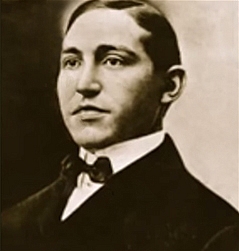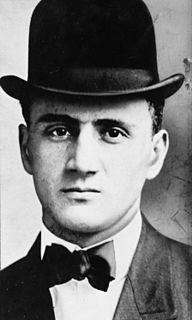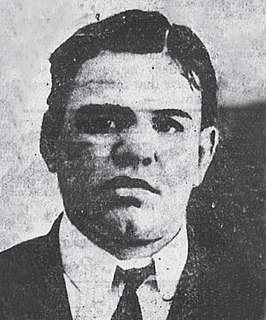Related Research Articles
"Kid Dropper" Nathan Caplin or Kaplan, also known as Jack the Dropper, was an American gangster controlling labor racketeering and extortion in New York City during the post-World War I period into the early years of Prohibition in the early 1920s.
Johnny Spanish was an American gangster who was a rival of former partner "Kid Dropper" Nathan Kaplan during a garment workers' strike which later become known as the Second Labor Sluggers War in 1919. He became involved in labor racketeering, holdups of saloons and other businesses, and murder before organizing his own gang.

The Lenox Avenue Gang was an early 20th-century New York City street gang led by Harry Horowitz; it was considered one of the most violent gangs of the pre-Prohibition era. It was based in Harlem in upper Manhattan, around 125th Street, in what was then a predominately Jewish neighborhood.

Paul Kelly was an Italian-American mobster and former boxer, who founded the Five Points Gang in New York City. He was born in Sicily. He had started some brothels with prize money earned in boxing. Five Points Gang was one of the last dominant street gangs in New York history. Kelly recruited young, poor men from the ethnically diverse immigrant neighborhoods of Lower Manhattan, including some who later became prominent criminals in their own right, including Johnny Torrio, Al Capone, Lucky Luciano, Meyer Lansky and Frankie Yale.
The Hudson Dusters were a New York City street gang during the early twentieth century. Formed in the late 1890s by "Circular Jack", "Kid Yorke", and "Goo Goo Knox", the gang began operating from an apartment house on Hudson Street. Knox, a former member of the Gopher Gang, had fled after a failed attempt to gain leadership of the gang from then-leader Marty Brennan. However the two gangs later became allies during the gang wars against Gay Nineties gangs, the Potashes and Boodle Gangs, soon controlling most of Manhattan's West Side as far as 13th Street and eastern Broadway, bordering Paul Kelly's Five Points Gang to the north. While the gang dominated the West Side, it constantly battled smaller rival gangs including the Fashion Plates, the Pearl Buttons, and the Marginals for control of the Hudson River docks throughout the 1900s. Eventually, it drove the rival gangs out through sheer force of numbers, with over 200 members, not including the Gophers, who numbered several hundred more, controlling the waterfront by 1910.

The Gopher Gang was an early 20th-century New York street gang known for its members including Goo Goo Knox, James "Biff" Ellison, and Owney Madden born in England of Irish ancestry. Based in the Irish neighborhood of Hell's Kitchen, the Gopher Gang grew to control most of Manhattan with their territory covering Fourth to Forty-Second Street and Seventh to Eleventh Avenue.

"Big" Jack Zelig was an American gangster and one of the last leaders of the Eastman Gang.
The Dutch Mob was a New York pickpocket gang during the late nineteenth century.

Five Points Gang was a 19th-century and early 20th-century criminal organization, primarily of Irish-American origins, based in the Sixth Ward of Manhattan, New York City. In the early 19th century, the area was first known for gangs of Irish immigrants. Their descendants gradually moved out, to be followed by the next immigrants.

The Whyos or Whyos Gang, a collection of the various post-Civil War street gangs of New York City, was the city's dominant street gang during the mid-late 19th century. The gang controlled most of Manhattan from the late 1860s until the early 1890s, when the Monk Eastman Gang defeated the last of the Whyos. The name came from the gang's cry, which sounded like a bird or owl calling, "Why-oh!"

Edward "Monk" Eastman was a New York City gangster who founded and led the Eastman Gang in the late 19th and early 20th century; it became one of the most powerful street gangs in the city. His aliases included Joseph "Joe" Morris, Joe Marvin, William "Bill" Delaney, and Edward "Eddie" Delaney. Eastman is considered to be one of the last of the 19th-century New York City gangsters who preceded the rise of Arnold Rothstein and the Jewish mob. Later, more sophisticated, organized criminal enterprises also included the predominately Italian Cosa Nostra.
The Bugs (Bugsy) and Meyer Mob was a Jewish-American street gang in Manhattan, New York City's Lower East Side. It was formed and headed by mobsters Bugsy Siegel and Meyer Lansky during their teenage years shortly after the start of Prohibition. The Bugs and Meyer mob acted as a predecessor to Murder, Inc.
Richard "Richie" Fitzpatrick was a top gunman in the Monk Eastman gang in New York City. He had defected from the Five Points Gang in the early 1900s; he was active during the late 1890s until his murder in 1904.

Waxey Gordon was an American gangster who specialized in bootlegging and illegal gambling. An associate of Arnold Rothstein during prohibition, he was caught up in a power struggle following Rothstein's death. Fellow Rothstein associates Charles Luciano and Meyer Lansky provided authorities with evidence that led to his imprisonment for ten years.

The Eastman Gang was the last of New York's street gangs which dominated the city's underworld during the late 1890s until the early 1910s. Along with the Five Points Gang under Italian-American Paolo Antonio Vaccarelli, best known as Paul Kelly, the Eastman gang succeeded the long dominant Whyos as the first non-Irish street gang to gain prominence in the underworld during the 1890s. Its rise marked the beginning of a forty to fifty-year period of strong Jewish-American influence within organized crime in New York City.
The 116th Street Crew, also known as the Uptown Crew, is a powerful crew within the Genovese crime family. In the early 1960s, Anthony Salerno became one of the most powerful capos in the family. Salerno based the crew out of the Palma Boys Social Club located 416 East 115th Street in East Harlem, Manhattan. By the late 1970s and early 1980s, the 116th Street Crew had absorbed and initiated many former members of the vicious East Harlem Purple Gang, an Italian-American murder for hire and drug trafficking gang operating in 1970s Italian Harlem and acting generally independent of the Mafia.
"Big" Jack Poggi or Pioggi was an American saloon keeper and underworld figure in New York City at the start of the 20th century. A rival of "Big" Jack Zelig, he had been the chief bouncer at Callahan's Dance Hall before opening a Lower East Side resort on Doyers Street near Chinatown's notorious "Bloody Angle". The building, known as Poggi's, could be reached through five Chatham Square alleyways, one of these being though a local dairy store and another through the back door of a barbershop, and was known to be a place "where anything goes". He later became partners with Chick Tricker, a member of the Eastman Gang, who bought an interest in his establishment to retain a connection in the district while he expanded his holdings elsewhere in Manhattan. His brother Louis "Louie the Lump" Poggi, a well-known gunman and member of the Five Points Gang, was responsible for the murders of Max "Kid Twist" Zwerbach and his bodyguard Vach "Cyclone Louie" Lewis in 1908.
Vach "Cyclone Louie" Lewis was an early New York gangster and member of the Eastman Gang under Max "Kid Twist" Zwerbach.
Jack Sirocco (1882–1954) was a New York City gangster involved in labor racketeering and strikebreaking. Originally a lieutenant in Paul Kelly's Five Points Gang, where he was the immediate boss of Johnny Torrio, Sirocco defected to the rival Eastman Gang, which he led in its last days.

The Short Tails also known as the Short Tail Gang for their distinctive short tailed jacket coats were an 1880s-1890s Irish gang located in the Corlear's Hook section of the Lower East Side on Rivington street in the vicinity of Mangin and Goerck streets of Manhattan, in New York City. The Eastman Gang were also headquartered around Corlear's Hook and may have had its beginnings as a break away gang of the Short Tail Gang. The Short Tails along with rival gangs the Daybreak Boys, Patsy Conroy Gang, Swamp Angels, and Hook Gang worked the New York City waterfront plundering ships of their cargo on the East River. The Short Tail Gang was photographed in 1887, under a pier by noted photographer Jacob Riis, being one of the few 19th century New York gangs to allow its members to be photographed. In fear of being identified and arrested by the law, usually individual police mug shots were the only criminal pictures known to exist.
References
- Asbury, Herbert (1928). The Gangs of New York. New York: Alfred A. Knoff.
- Rose, Joe (1996). The Big Book of Thugs. Factoid Books.